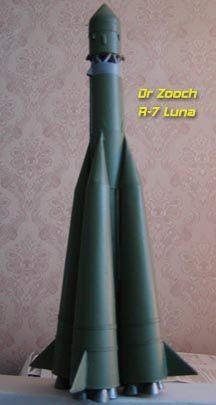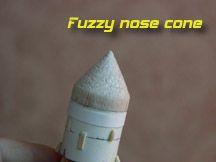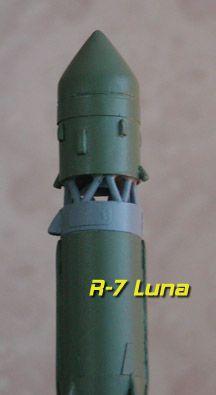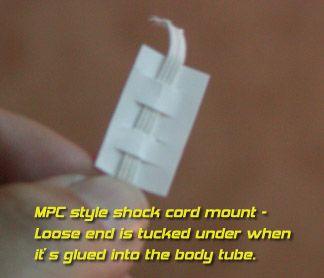| Construction Rating: | starstarstarstarstar_border |
| Flight Rating: | starstarstarstarstar_border |
| Overall Rating: | starstarstarstarstar_border |

Brief:
Sport scale craftsman's kit of the Russian R-7 booster with the Luna payload.
Requires quite a bit of modeling skill for a model rocket and I wouldn't
recommend it for women, children, or weak persons. If you're the kind of person
who absolutely needs your balsa to be laser cut and falling out of the
balsa sheets already, then move along. This kit's not for you. If you're a man,
I mean a "real man's" man, in the Hemingway sense of the word, who
likes to build his rockets, please come along for the ride...
Construction:
Over a period of time, I acquired all the Dr Zooch kits from Rebar Rocketry, a
highly recommended vendor, and the most recent acquisition being the R-7 Luna.
Being a huge fan of the R-7 booster design, I thought it would be the most fun
to dig into first. The kit came packed in a sturdy 3.5"x3.5"x12"
mailer box with all the parts neatly packed inside. The parts included:
- 1 6 7/8" long BT-20 core tube
- 1 3 1/8" long BT-50 upper sustainer tube
- 2 2050 centering rings
- 1 Pre weighted balsa nose cone
- 1 Short balsa bulkhead
- 1 Long balsa bulkhead
- 2 Thin wooden dowels
- 2 Sheets balsa stock
- 1 Screw eye
- 1 Engine hook
- 1 Launch lug
- 1 Snap swivel
- 1 24" long 1/8" elastic Shock cord
- 1 Red trash bag parachute
- 1 Strip of chute reinforcement dots
- 1 Bundle of bullet proof Kevlar® (TM) shroud line material
- 1 Tank rolling dowel
- 3 Card stock wrap sheets
- 1 Set of instructions.[NOTE: Download the PDF with the updated instructions for this kit before you start building. Steps 6 and 7 have some changes made that you are made aware of before you get there.]

All of the parts were accounted for. Actually, there were actually more parts than were listed in the instructions--there were 2 thin dowels and 2 small sheets of balsa stock rather than one of each listed) so there was no shortage of pieces to complete the rocket. Everything was of good quality materials. The nose cone was a bit "fuzzy" with a lot of open grain. I'm sure that this was due to the fact that the cone is extremely short, going from the tip of the cone all the way out to a BT-50 diameter in 3/4"--that's an extremely blunt cone being cut cross grain. It requires a bit of strengthening, filling, and sanding to get a good finish. That's nothing however, compared to the amount of work that's going into the rest of the build. The BT-20 and BT-50 tubes are the only "normal" part of the build here. Even the BT-50 has to be cut into 3 shorter tubes. You will need good scissors, a straight edge, and a new X-Acto blade to cut out the following parts from the cardstock sheets:

- 2050 paper adaptor
- 4 main booster strap-on bodies
- 4 strap-on nose cones
- 17 engine bells!
- 8 booster trim strips
- Various cutting and alignment guides
- Fin and booster base templates
Most of these parts have to be rolled to form structural parts, some of which could actually benefit from a little practice if you don't do this kind of modeling that often. The instructions state that Dr Zooch has graciously provided extras of the engine bells for the base of the rocket but I only counted the required number. What would actually be beneficial is possibly one extra sheet of the strap-on boosters. There are two boosters on each sheet. You are given two of those, so you have enough to build four boosters, but they can be challenging enough to build that one extra sheet would be nice to have just in case it takes one or two to actually get the hang of getting these things together (like it took me). It may well be worth scanning the booster sheet and printing onto comparable cardstock in order to cut them out and try then before committing to the real thing. More on that later though.
If all you've been building has been recent Estes laser cut and slotted stuff with lots of molded parts, welcome back to model rocketry from the Golden Age. I haven't had this much fun building a kit since I was in my parent's basement building my original Mars Lander while listening to Murray Saul play "Dynamo Hum" on WMMS when WMMS was worth listening to.
The instructions are 6 sheets of double sided typing paper profusely illustrated with old-style Estes line drawings. If you have been keeping up with the reviews or are familiar with any of the other kits from this manufacturer, you are aware that the instructions have a certain amount of sarcastic wit about them, which you will either love or hate. I find it amusing. (Much like having my old buddy Nick D telling me how to build a rocket from scratch.)
Beginning assembly is fairly straightforward, starting with marking the BT-20 body tube and installing motor retention. This kit does have an engine hook, but no engine block, which is common in other Dr Zooch kits as well. It saves 20 cents or so in the kit cost, and is easily remedied with a razor saw and an expended engine casing. Next, a "tube cutting guide" is cut from the cardstock and wrapped around the BT-50. The builder can even cut two pieces off the BT-50. This is where the updated instructions come in. The pieces should be 3/8" and 1" long, as opposed to the 3/8" and 3/4" with the included instructions. Then, the longest piece of BT-50 is attached to the forward end of the BT-20 tube with the 2050 centering rings and a paper transition that is also cut from the cardstock. The next step is the addition of balsa "spider beams" made from small balsa strips used to align the strap-on boosters. The instructions describe them as being "no more than 1/8 inch wide and 3 1/4 inches long" and fitting between the base of the transition and the top of a reinforcement band that goes under the motor retainer clip. Oddly enough, I only had 2 3/4 inch length between these two points. Being reasonably sure I followed the instructions fairly exactly and worried that a blunder on my part would screw up my build down the line, I fired off an email to Dr Zooch (which was quite promptly answered I might add) and found that the spider beam length was irrelevant and only for alignment purposes. I think that Dr Zooch built his and wrote the instructions afterwards, relying on a "best guess" estimate for the size of this particular aspect of the kit. I based this on the fact that for all the templates and alignment guides included on the cardstock, there was no pattern for the spider beams themselves. That question being answered, I continued with my build.
Then comes the cutting and rolling of strap-on parts. This is where it gets a little tougher if you haven't done this much before. I found some good tips on paper modeling on The Rocketry Forum about getting the parts pre-curled, most notably using the tank rolling dowel like a rolling pin, with the part to be curled on a pliable yet moderately firm surface like a neoprene mouse pad. It takes quite a bit of pressure but the prepared parts will have enough curl in them to make this part of the job easier--at least for the open ended cone that is the main body of the strap-on. I used my regular Elmers's wood glue on the glue tab, which is quite large and dries quite hard. If the paper hasn't been pre-curled quite enough to hold it's shape, you will end up with a less than circular cross section through the booster. If I were to do it again, I would probably cut the glue tabs off completely and glue them on the back of the cones using rubber cement as described in the instructions for the Apogee Saturn V kit and detailed in the Apogee "Peak of Flight" newsletter in the article about making your own paper transitions. The rubber cement stays flexible and allows for a smooth, pliable curve through the glued area. The smaller, fully closed cones at the forward end of the boosters come to a sharp point and are a true pain in the neck to roll and glue smoothly. Rubber cement would help here, as well as a few extras of these parts to allow for the foul ups that will likely occur, especially since I have fingers the size of Twinkies. Balsa disks that are cut from the balsa stock are glued into the base of the cones after assembly for both strength and roundness. The circle template seemed to be a little on the large side, so they needed to be sanded down a little to fit. A good pointer here would be to sand a bevel onto the edge of the disk (instead of straight sides) since you're going to be inserting it into a cone rather than something with parallel sides like a body tube. It will seat better and give less of a gap to fill around the edges of the disk.
Next is attaching the strap-ons to the main body and the slightly oversized fins to the strap-ons. This is easy enough with the included templates and the spider beams are a great help in keeping the boosters aligned and free from rolling out of position. Once those are dried, cut out and roll the 16 engine bells then glue them to the bottom of the strap-ons. Seeing as the engine bells may be the first thing to hit the ground, I wicked in some thin CA for strength after attaching them. Wes also suggests the same for the fins.
 The interstage/nosecone section is next. A thin dowel is cut
into 1/2 inch pieces with an angle sanded into the end then glued into 5
"V" shapes. These are then glued onto a tube/bulkhead part using a
clever alignment sleeve, which has been cut and rolled from one of the
cardstock sheets. The result is fine for a fun-scale rocket (and this kit is
far from true scale), but if I were to do it again, I would probably get or
make thinner dowels and do the math to come up with the proper number of
trusses. The same alignment guide is used to glue the second stage section on
which pretty much completes the construction of the rocket, save for the
addition of the recovery system. Dr Zooch details using one of the Estes-style
three fold shock cord mounts, gluing it "to the inner wall of the main
body tube about one inch down." I strongly advise against this as the
BT-50 tube at the forward end is only 1" long, and 7/8" of this is
used by the shoulder of the nose assembly. I opted to make an approximation of
the old MPC style punched cardstock mount, with the shock cord laced through
this, and mounted it down into the T-20 tube as far as my pinky finger could
reach. It may have been smarter to do a Kevlar®
anchor to a thrust ring, but I was too lazy to get off my butt and go find one.
I hope I don't regret that decision. The 15" trash bag chute is then
assembled and construction is complete. I sat back, looked at the rocket, and
decided to add a few details to make it look cooler. As my kit came with an
extra dowel, I used it, some scrap balsa, some pieces of coffee stir stick, and
leftover cardstock to make some raised panels, retro rockets, and equipment
tunnels to dress my model up a bit.
The interstage/nosecone section is next. A thin dowel is cut
into 1/2 inch pieces with an angle sanded into the end then glued into 5
"V" shapes. These are then glued onto a tube/bulkhead part using a
clever alignment sleeve, which has been cut and rolled from one of the
cardstock sheets. The result is fine for a fun-scale rocket (and this kit is
far from true scale), but if I were to do it again, I would probably get or
make thinner dowels and do the math to come up with the proper number of
trusses. The same alignment guide is used to glue the second stage section on
which pretty much completes the construction of the rocket, save for the
addition of the recovery system. Dr Zooch details using one of the Estes-style
three fold shock cord mounts, gluing it "to the inner wall of the main
body tube about one inch down." I strongly advise against this as the
BT-50 tube at the forward end is only 1" long, and 7/8" of this is
used by the shoulder of the nose assembly. I opted to make an approximation of
the old MPC style punched cardstock mount, with the shock cord laced through
this, and mounted it down into the T-20 tube as far as my pinky finger could
reach. It may have been smarter to do a Kevlar®
anchor to a thrust ring, but I was too lazy to get off my butt and go find one.
I hope I don't regret that decision. The 15" trash bag chute is then
assembled and construction is complete. I sat back, looked at the rocket, and
decided to add a few details to make it look cooler. As my kit came with an
extra dowel, I used it, some scrap balsa, some pieces of coffee stir stick, and
leftover cardstock to make some raised panels, retro rockets, and equipment
tunnels to dress my model up a bit.

Finishing:
There isn't much balsa to fill, just the 4 small fins and the nose cone. I
covered the circles at the base of the booster cones with wood glue when I
glued on the engine bells, so those didn't require any filling. Dr Zooch
provides you with two different paint schemes, the "perceived" color
scheme (from incorrectly color balanced cold-war era photographs) and the
"actual" color scheme. I chose the incorrect color scheme, sort of. I
based the entire thing out with gray primer, masked off the small section that
was to remain gray, then hit it with olive drab. The finished paint job looked
a little dull, so I dusted it just slightly with a bit of Krylon Crystal Clear
just to kick a few highlights, and was pretty satisfied with the results. There
were no decals included with the kit.
Construction Rating: 4 out of 5
Flight:
Dr Zooch, without getting too specific, only recommends B and C motors. As I
didn't have access to a regular club launch field and had to settle for a local
city park surrounded by trees and a public pool, I settled for a B6-4, which I
figured would be a good flight. Model was prepped using dog barf for wadding.
Packing the chute was a bit on the tight side as you really need to get it
through the BT-50 upper tube and into the BT-20 lower body tube in order to get
the nose cone on. On a B6-4, the flight was pleasantly peppy, as the model
builds fairly light. Since I was pretty close and my eyes aren't calibrated
that well, I'd say it hit between 200-300 feet conservatively speaking. It
really ought to rip on a C engine. Flight was very straight and the 15 inch
chute brought it back fairly close to the pad. It does descend fairly quickly
but since it landed on grass, there was no damage. A couple of folks who
watched my flight commented on the unique appearance of the rocket as all they
were familiar with was the "Questes" tube and fins type rockets.
Overall it was a very good flight and I will be looking forward to launching
again in the future.
Recovery:
PROs: Nice straight flight. Good flyer.
CONs: Chute could be a little larger, if there was enough room to pack it in there.
Flight Rating: 4 out of 5
Summary:
PROs: This is a builder's kit. It brings back the fun you had when you were a
kid and actually had to build a rocket, rather than toss a tube of glue
into the box, shake it a couple of times, and pour out a completed rocket. It
doesn't look like every other rocket on the pad. It was a fun build and I look
forward to getting another and possibly bashing it into a Vostok.
CONs: Could use an extra sheet or two of the cardstock parts as they can be a bear to roll into shape without screwing up a part or two and they can't be that expensive to include. Maybe a sheet of hints on cardstock model building or at least a web link to a card model builder's hints and tips page might be in order. They also may want to rethink the shock cord attachment instructions.
Overall Rating: 4 out of 5
Other Reviews
- Dr. Zooch R-7 Sputnik By John Pate (June 20, 2013)
This is the R7 Sputnik launch vehicle by Dr Zooch. The R7 Semyorka launched Sputnik into space on October 4, 1957 and was the first man-made object in space. The R7 went on to be the launch vehicle for the Vostok, Voshod. and the Soyuz program. This kit features paper-rolled strap-on boosters, so it may be a challenge for some. Components Good components, ...
 |
 |
Flights
 |
 |
 |
 |

A.F. (July 3, 2005)